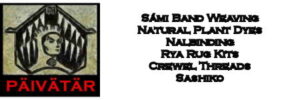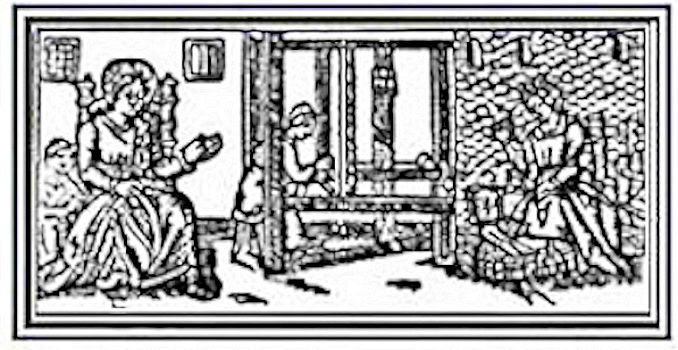How to Weave a Good Edge
One of the biggest challenges for the beginner weaver is to be able to obtain clean edges, free of loops or tightly drawn wefts that result in broken threads. Don’t despair! With a bit of practice, your edges will improve.
When a weft yarn travels across the warp, it takes more weft than the width of the warp. This is because the weft is actually travelling up and down between the warp threads. If you throw the shuttle across the warp, and have the yarn running straight across, when you beat
the weft down into place, you will not have enough weft yarn to adequately cover the area. This will result in too much draw-in and can cause the edge warp threads to break.

Instead, when throwing the shuttle allow some extra weft to make allowance for the draw-in. A simple way to do this, is to throw the shuttle and have the weft yarn travel in a V-shape, uphill from the edge of the woven cloth up to the reed. When you beat, the extra yarn allowance will beat into place. You will still have a bit of draw-in but it shouldn’t result in broken threads. To improve your weaving speed, try not to touch or fiddle with the edges while weaving. It
will take only a bit of practice, but you should notice an improvement.
The other problem that most of us have with selvages, is having loops that stick out unattractively, instead of a nice clean edge. This happens because too much weft was left out when the shuttle was thrown across. This can be corrected by a visual check and making an adjustment with the shuttle.
When throwing from the left to the right, I throw the shuttle with my left hand and catch it with my right. Then I look to see (don’t touch!) if the weft yarn just thrown is just touching the outer edge of the selvage. If not, then I give a slight tug on the shuttle to pull the weft yarn into place. The right edge of the weft yarn is up at an angle almost at the reed – as in the diagram above. Then I beat, with my left hand, placing the weft into place. Change sheds and repeat the procedure working from the right.
When you weave, you may notice that one side of your work has a tendency to either have tighter edges or have more loops. This is because one side of your body is stronger than the
other. You will need to be aware of this and make adjustments to your weaving as necessary to improve your weaving technique.
How To
How to make a Warping Board
How to Weave a Mirror Warp
How to Use a McMorran Balance
How to Weave Clasped Weft
AMAZON Hand Weaving Books
The Key to Weaving: A Textbook of Hand Weaving for the Beginning Weaver
The Weaver’s Companion (The Companion Series)
Learning to Weave
The Big Book of Weaving: Handweaving in the Swedish Tradition: Techniques, Patterns, Designs and Materials
The Handweaver’s Pattern Directory
EBAY Weaving Yarn
Weaving Yarn – US
Weaving Yarn – UK
 LONGTHREAD MEDIA VIDEO
LONGTHREAD MEDIA VIDEO
 LONGTHREAD MEDIA SUBSCRIPTIONS
HANDWOVEN MAGAZINE
PIECEWORK MAGAZINE
SPINOFF MAGAZINE
LEARN LONGTHREAD MEDIA
PAIVATAR HANDMADE
LONGTHREAD MEDIA SUBSCRIPTIONS
HANDWOVEN MAGAZINE
PIECEWORK MAGAZINE
SPINOFF MAGAZINE
LEARN LONGTHREAD MEDIA
PAIVATAR HANDMADE
 Paivatar on YouTube
Visit my YouTube channel for how-to craft videos.
Paivatar on YouTube
Visit my YouTube channel for how-to craft videos.
Or Please visit my Channel on Rumble for more how-to videos.
https://rumble.com/Paivatar
LIVE STREAMS - Paivatar Studio
KICK
TWITCH MAKERS&CRAFTING
YOUTUBE
Categories: HAND WEAVING, How To



